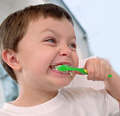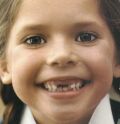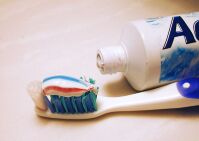 Index
Index

You can learn to take better care of your teeth by understanding the structure of the teeth and their environment. The mouth, or oral cavity, includes the lips, teeth, gums, tongue, salivary glands, and the lining of the cheeks. Although the main function of the teeth is to chew the food to make it more digestible, the teeth are also necessary for human speech. Sibilant sounds such as the letter "S" are produced by releasing air between the teeth to produce a hissing sound.
The tongue has muscles that help to position food so that it can be chewed properly. The tongue also has receptors for taste, called taste buds. During chewing, the salivary glands release saliva containing enzymes, such as amylase, that break down complex carbohydrates into digestible sugars. It is important to practice good dental hygiene to avoid tooth decay and gum diseases.




Milk Teeth
Humans have two sets of teeth. The first set, called milk teeth,
start to show when babies are six or seven months old.
Most children have a full set of 20 milk teeth by age three.
Starting at around the age of five or six, the first set of teeth starts to be pushed out
by the permanent teeth, and by the age of 14 all the milk teeth have generally been replaced by a
full set of 28 permanent teeth. Around age 20, four more teeth grow in the back of the mouth to
complete the adult set of 32 teeth.
Children should learn to take care of their teeth while they still have their milk teeth. In this way, they will know how to avoid cavities and gum diseases when they have their permanent teeth. It is important to have a dental exam and dental cleaning at least once per year. Regular visits to the dentist will help to identify and correct problems at an early stage.
Tooth Composition
Teeth and bones consist mainly of an inorganic calcium phosphate mineral called apatite.
The most common form of apatite in teeth is hydroxyapatite,
Ca5(PO4)3OH. However, the hydroxyl groups are frequently
replaced by fluoride (F-) ions to form fluorapatite, Ca5(PO4)3F.
Fluorapatite is more resistant to cavities than hydroxyapatite.
Tooth enamel consists of approximately 96% inorganic material, whereas
dentin, the material under the tooth enamel, consists of 70% of inorganic material and the
rest is mostly collagen which acts as a binder.
Teeth are formed by specialized cells that stimulate mineralization through specific proteins.
Odontoblast cells which are in the pulp of the tooth secrete dentin throughout life, but ameloblast cells,
which produce enamel, are only active before the teeth erupt in the jaw. For this reason, enamel lost
by abrasion or decay cannot be regenerated.
Avoid abuse and injuries
Although teeth are the hardest part of the human body, they can be damaged by
using them improperly. Chewing on hard objects like bones or trying
to crack nuts or open bottle caps with the teeth can chip or break the teeth.
Teeth may also break and fall from their sockets as the result of strong
impacts to the face that may occur from falls while skating, riding a bicycle or
in sports such as football, basketball, hockey, or boxing. Always wear protective
mouth guards when playing rough sports.
Acid drinks harm the teeth
What you eat, drink, and put in your mouth can affect your teeth. Dark beverages like coffee or tea
have resins which over time accumulate on the teeth and make them look yellowish or brown.
Cigarettes and other tobacco products deposit brown tar on the teeth and put noxious
cancer-causing chemicals on the soft tissues of the oral cavity.
Soft drinks containing citric acid or phosphoric acid dissolve the enamel and make the
teeth more prone to decay.[1]
Many sports drinks, including Gatorade, have a pH (acidity) below 5.5 which can cause enamel demineralization.[4]
Teeth can also be damaged by frequent vomiting which brings strong stomach acids and enzymes
in contact with the teeth and causes erosion of the enamel and exposes the underlying yellow dentin.
Bacteria
Hundreds of different types of bacteria live in the mouth and in the digestive tract.
These bacteria receive nutrients from the foods that we eat every day, but they
generally do not cause disease and are called "normal flora".
The bacteria are part of the microbiome and may prevent infections by pathogenic organisms.
The bacteria in the mouth produce a sticky polysaccharide called
dextran which along with food debris and salivary proteins
form a soft film
called dental plaque. When this film eventually hardens, it is called tartar.
Some examples of normal oral bacteria are Streptococcus salivarious and Streptococcus mutans. Although these bacteria themselves do not cause disease, Streptococcus mutans converts sugars to lactic acid that is strong enough to dissolve tooth enamel and start tooth decay if it remains on the teeth for extended periods of time.
Plaque also harbors anaerobic organisms which grow in the absence of air and are found between the teeth and under the gum line. Porphyromonas gingivalis, a leading cause of periodontal disease, releases enzymes and toxins that cause the gums to become swollen and bleed. If not corrected, the supporting structures of the teeth may be destroyed.
Tooth decay
Tooth decay, or dental caries, often starts as an opaque white spot
on the surface of a tooth. The spot indicates an area where bacterial acids
are leaching minerals from the tooth enamel.
If the demineralization continues, the enamel and dentin are destroyed, and a cavity
forms in the tooth.
If the bacterial infection remains untreated, it can reach the pulp and cause
severe tooth pain.
Saliva helps to neutralize some of the acids produced by oral bacteria. However,
once plaque is formed, the acids cannot be washed away by saliva, by rinsing with water,
or by eating fibrous foods.

Brushing
Brushing stimulates the gums and cleans the teeth.
People who wear braces should brush after each meal or snack.
Brushing two times a day with toothpaste, specially after breakfast and before bed,
helps to reduce plaque formation, according to the American Dental Association.
Toothpaste contains mild abrasives, surfactants, and
acid neutralizers that clean the teeth gently. In addition, some toothpastes
have fluoride that strengthens the teeth if used in moderation. Excessive
fluoride during tooth development can cause tooth discoloration and mottled teeth.
This condition is called dental fluorosis.
Use only a small amount of toothpaste (about the size of a pea), and
avoid swallowing toothpaste and other dental
hygiene products. After brushing, spit out the toothpaste and rinse your mouth with water.
Most dentists recommend brushing the tooth surfaces in a circular motion using a soft toothbrush with round-ended bristles that will not scratch the teeth or irritate the gums. Brush only a small group of teeth at a time, and gradually cover the entire mouth. Make sure to brush the biting surfaces of the molars, as well as the inside and outside surfaces of all the teeth. Some people prefer to use battery powered tooth brushes because they they have larger handles and are easier to hold. Children may also find a power brush more fun to use, so they will brush with greater regularity. It is important to maintain a circular or elliptical brushing motion because a back-and-forth motion may cause erosion of the enamel at the base of the gums or abrade the gum and expose the root surface of the tooth. Erosion of the enamel makes the teeth very sensitive to cold and hot liquids.
Brushing or scraping the tongue with a tongue cleaner is often used to remove the soft plaque from the back of the tongue. Tongue cleaning does not kill the bacteria that cause bad breath; it simply removes the food particles that are a food source for anaerobic bacteria, and reduces the primary source of gaseous sulfur compounds that cause bad breath (halitosis). Application of an oxygenating toothpaste (with peroxide) to the tongue in conjunction with scraping kills many of the bacteria and freshens the breath.


Flossing
Dental floss is a waxed or unwaxed piece of nylon string that is used to remove plaque
or food deposits between the teeth and under the gum line where a toothbrush cannot reach.
Flossing is just as important as brushing. Persons with closely-spaced teeth
generally prefer waxed floss because it slides between the teeth easier than unwaxed floss.
The procedure for flossing consists of winding a piece of floss around the index fingers of
both hands and gently working the floss with a back-and-forth motion between every pair of teeth
making sure that the surfaces of both teeth are cleaned.
Brush before flossing
Periodontists are about equally divided on whether you should floss before brushing
or brush before flossing. Taking into consideration that flossing may carry
bacteria and food particles below the gum line, it is probably better to brush first to reduce the
food particles, bacteria, and foreign matter that can be transferred below the gum line by
the floss. The argument for flossing before brushing is based on the idea that the
fluoride in toothpaste can only strengthen teeth by coming in direct contact with the enamel.
Removing the plaque by flossing can expose the enamel to the beneficial effect of
the fluoride in toothpaste, and the plaque between the teeth cannot be removed by brushing anyway.
The important thing is to floss to keep the teeth clean. Rinsing with mouth wash before flossing
can kill bacteria that could be transferred below the gum line by flossing.
Mouth Rinses
Mouth washes and rinses are used for cosmetic and therapeutic purposes. Most
mouth washes sold without prescription temporarily suppress bad breath, refresh
the mouth with a pleasant taste, and may diminish the bacteria in the mouth.
The ingredients of mouth washes vary, but some contain levels of alcohol
as high as 26 percent. Alcohol-containing mouth washes may produce a burning sensation
in the cheeks, teeth, and gums, or may cause intoxication if swallowed.
A breath test for intoxication may come out positive after using a mouthwash
containing alcohol.
Tooth Bleaching
White teeth are considered to be an attractive feature of a smile. For this reason,
tooth bleaching or tooth whitening has become a common procedure in general dentistry and in
cosmetic dentistry. The bleaching agent is usually a gel containing either hydrogen peroxide or
carbamide peroxide. A mouthguard filled with the bleaching gel is held in contact
with the teeth from several minutes to many hours, depending on the concentration of the
bleaching agent. Tooth bleaching is generally a safe procedure, but chemical burns may
occur if soft tissues come in contact with the gel.
Some people also report increased thermal sensitivity of the teeth after the bleaching procedure.
Periodontal Diseases
The word periodontal means "around the tooth". Periodontal diseases,
also called gum diseases, are serious bacterial infections that destroy the gums
and the surrounding tissues of the mouth. Untreated infections cause deterioration of
the bones around the teeth. Approximately 70 percent of adult tooth losses
are due to periodontal disease. Bacteria and plaque build-up are the main causes
of gum disease.
Gum diseases require diagnosis and treatment by a qualified dentist or oral health specialist.
The most common symptoms of a gum diseases such as gingivitis include:
Some studies show that people with periodontal disease have nearly twice the risk of heart attack as people with healthy gums.[2,3] It is thought that the bacteria in the gums release toxins that cause inflammation and may cause blood clots that interfere with circulation.
Oral cancer
Oral cancer is cancer found in the oral cavity and the
oropharynx (the throat area at the back of the mouth).
Approximately 30,000 Americans each year are diagnosed with oral cancer.
The main causes of oral cancer include the use of tobacco and alcohol.
Eighty to ninety percent of oral cancers are caused by smoking cigarettes,
cigars, pipes, chewing tobacco, and dipping snuff.
Toxic chemicals in tobacco damage cells in the mouth area and cause abnormal cells to grow
more rapidly. According to the American Cancer Society, 75 to 80 percent of patients
with oral cancer use alcohol frequently.
Questions have been raised about whether mouthwashes with alcohol
increase the risk for oral cancer, but there is no conclusive evidence that
mouthwashes increase the risk for persons who do not drink or smoke.